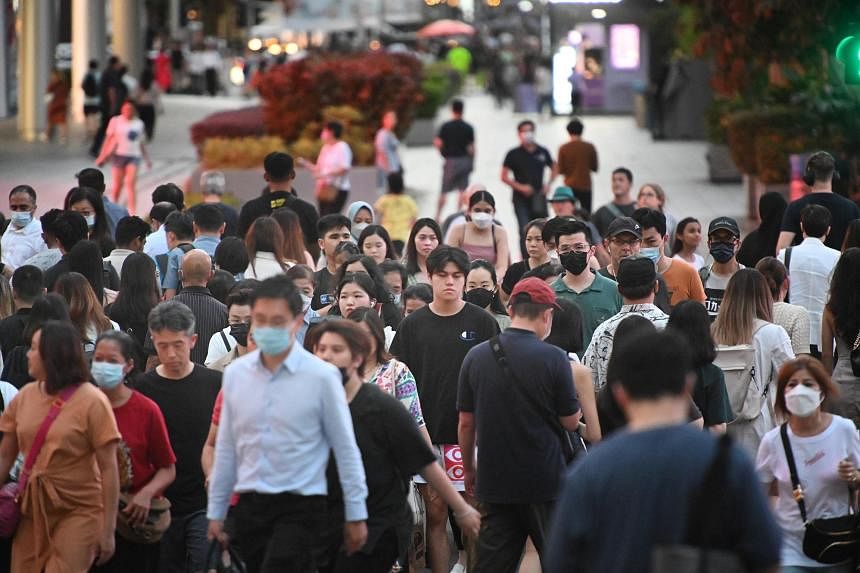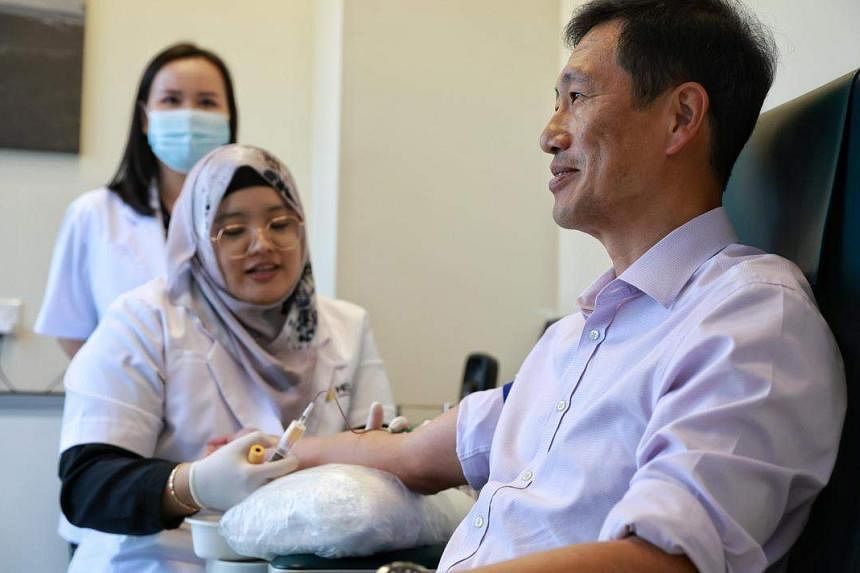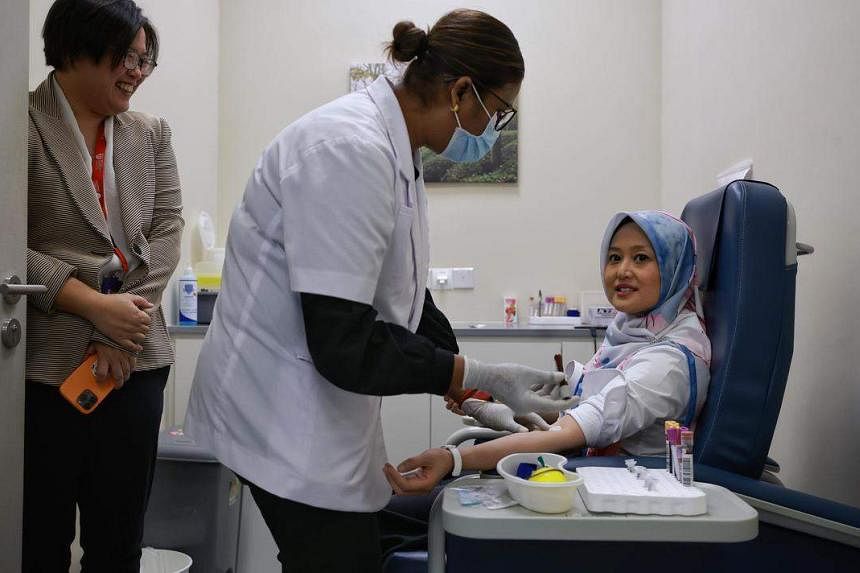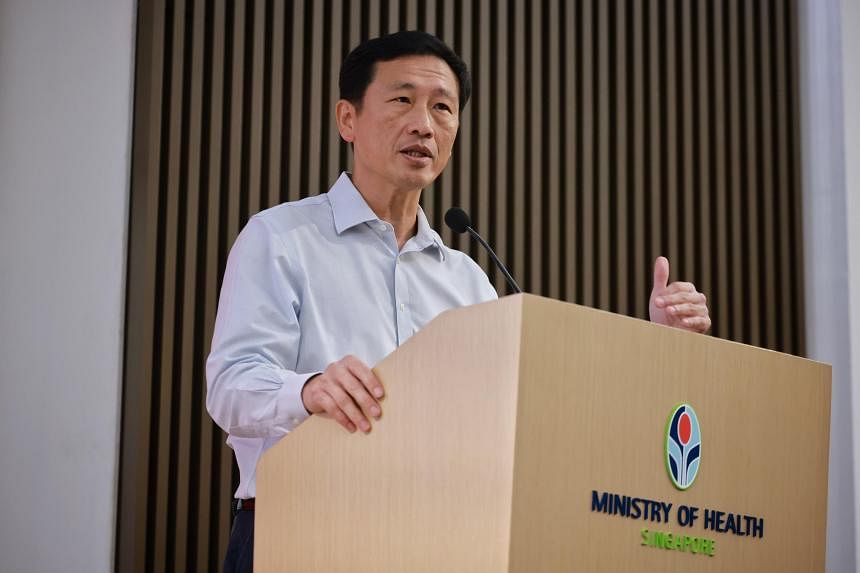- Joined
- Jul 14, 2008
- Messages
- 89,988
- Points
- 113
from straitstimes.com:

When completed, the SG100K study will create one of the Republic’s biggest research data sets. ST PHOTO: DESMOND WEE

Ang Qing
UPDATED
17 DEC 2022, 12:19 AM SGT
FacebookTwitter
SINGAPORE – Men aged 30 to 40 are needed for Singapore’s quest to map the DNA of 100,000 Singaporeans as part of research to find new ways of predicting and preventing diseases here and in Asia.
Making this call on Friday after the official launch of the study, its lead investigator, Professor John Chambers of Nanyang Technological University’s (NTU) Lee Kong Chian School of Medicine (LKCMedicine), said he has observed that working adults below 40, particularly men, find it difficult to make time for the study. It involves a check-up that lasts an average of about five hours.
When completed, the SG100K study will create one of the Republic’s biggest research data sets, which will yield insights over the next three decades into the genetic basis for diseases in Singaporeans.
Since recruitment for the study began in January, nearly 20,000 people have signed up, said Prof Chambers, who is also chief scientific officer at Precision Health Research, Singapore.
Another 50,000 participants have been drawn from four existing cohort studies under LKCMedicine, National University of Singapore’s Saw Swee Hock School of Public Health, the Singapore Eye Research Institute, the Singapore National Eye Centre and the National Heart Centre Singapore.
Prof Chambers said: “So, for this work to be relevant to everyone in Singapore, it is very important that we reach out and include all segments of Singapore society – the rich, the poor, the young, the old, men and women and also people of different social and cultural backgrounds.”
Over the next three years, researchers will analyse the whole genomes of 100,000 Singaporeans aged 30 to 84, and other health data, to understand the social, environmental, lifestyle and genetic factors associated with diseases prevalent in Singapore and Asia.
Most knowledge of human health and diseases stems from the West, and special features of the Asian genome, lifestyle, environmental issues and predisposition to diseases are not entirely clear, said NTU’s senior vice-president of health and life sciences and LKCMedicine’s dean, Professor Joseph Sung.
With Malays and Indians comprising 40 per cent of participants, the project is slated to become one of Asia’s leading reference genome databases because Singapore’s ethnic diversity captures more than 80 per cent of Asia’s diversity.
Over the next two years, the institutions will work to recruit about 30,000 people, NTU said in a statement. Participants in the study will go for a health check-up that involves collecting blood samples, measuring blood pressure, and collecting information on physical fitness, lung function, body composition, skeletal health and cognitive performance, as well as glucose and cholesterol levels.
The study is open to Singaporeans and permanent residents of all ethnicities, aged 30 to 84, including people with pre-existing conditions. Each participant will receive a $50 token of appreciation after the check-up.
Over the course of the study, SG100K participants will be monitored for their long-term health outcomes through a combination of approaches, including electronic medical records, disease registries and invitations for further follow-up.
Among those who have volunteered are Health Minister Ong Ye Kung and Senior Parliamentary Secretary for Health Rahayu Mahzam, who had their blood and skin samples taken on Friday.

Health Minister Ong Ye Kung having his blood sample taken by research assistant Halimah Ibrahim at the launch of SG100K study. ST PHOTO: KEVIN LIM

Senior Parliamentary Secretary for Health Rahayu Mahzam also volunteered for the SG100K study. ST PHOTO: KEVIN LIM
Speaking at the launch, Mr Ong said knowledge from the multi-ethnic study will enable and turbocharge the development of precision medicine in Singapore.
This will enable clinicians to customise medication and treatment according to the genetic make-up of patients and identify those at higher risk of developing diseases, he said.
At the same time, the profound and potentially revolutionary implications of precision medicine mean that Singapore will need to take action now, he added, citing, among issues, the need to make preventive care accessible to all and finance healthcare.
He said: “Hence, for us to fully benefit from precision medicine, much work needs to be done in clinical development, ascertainment of cost and medical effectiveness, healthcare financing policies, legislation and determining what is encouraged, allowed and proscribed.
“And these issues will cut across clinical, economic and moral considerations. We will need a great deal of study, consultation and engagement with policymakers, physicians, economists, regulatory bodies, bioethicists, the public and also the patients.”
Those interested to sign up for the study can find out more details from this website.
Wanted: Men aged 30 to 40 for national study to map DNA of 100,000 Singaporeans

When completed, the SG100K study will create one of the Republic’s biggest research data sets. ST PHOTO: DESMOND WEE

Ang Qing
UPDATED
17 DEC 2022, 12:19 AM SGT
FacebookTwitter
SINGAPORE – Men aged 30 to 40 are needed for Singapore’s quest to map the DNA of 100,000 Singaporeans as part of research to find new ways of predicting and preventing diseases here and in Asia.
Making this call on Friday after the official launch of the study, its lead investigator, Professor John Chambers of Nanyang Technological University’s (NTU) Lee Kong Chian School of Medicine (LKCMedicine), said he has observed that working adults below 40, particularly men, find it difficult to make time for the study. It involves a check-up that lasts an average of about five hours.
When completed, the SG100K study will create one of the Republic’s biggest research data sets, which will yield insights over the next three decades into the genetic basis for diseases in Singaporeans.
Since recruitment for the study began in January, nearly 20,000 people have signed up, said Prof Chambers, who is also chief scientific officer at Precision Health Research, Singapore.
Another 50,000 participants have been drawn from four existing cohort studies under LKCMedicine, National University of Singapore’s Saw Swee Hock School of Public Health, the Singapore Eye Research Institute, the Singapore National Eye Centre and the National Heart Centre Singapore.
Prof Chambers said: “So, for this work to be relevant to everyone in Singapore, it is very important that we reach out and include all segments of Singapore society – the rich, the poor, the young, the old, men and women and also people of different social and cultural backgrounds.”
Over the next three years, researchers will analyse the whole genomes of 100,000 Singaporeans aged 30 to 84, and other health data, to understand the social, environmental, lifestyle and genetic factors associated with diseases prevalent in Singapore and Asia.
Most knowledge of human health and diseases stems from the West, and special features of the Asian genome, lifestyle, environmental issues and predisposition to diseases are not entirely clear, said NTU’s senior vice-president of health and life sciences and LKCMedicine’s dean, Professor Joseph Sung.
With Malays and Indians comprising 40 per cent of participants, the project is slated to become one of Asia’s leading reference genome databases because Singapore’s ethnic diversity captures more than 80 per cent of Asia’s diversity.
Over the next two years, the institutions will work to recruit about 30,000 people, NTU said in a statement. Participants in the study will go for a health check-up that involves collecting blood samples, measuring blood pressure, and collecting information on physical fitness, lung function, body composition, skeletal health and cognitive performance, as well as glucose and cholesterol levels.
The study is open to Singaporeans and permanent residents of all ethnicities, aged 30 to 84, including people with pre-existing conditions. Each participant will receive a $50 token of appreciation after the check-up.
Over the course of the study, SG100K participants will be monitored for their long-term health outcomes through a combination of approaches, including electronic medical records, disease registries and invitations for further follow-up.
Among those who have volunteered are Health Minister Ong Ye Kung and Senior Parliamentary Secretary for Health Rahayu Mahzam, who had their blood and skin samples taken on Friday.

Health Minister Ong Ye Kung having his blood sample taken by research assistant Halimah Ibrahim at the launch of SG100K study. ST PHOTO: KEVIN LIM

Senior Parliamentary Secretary for Health Rahayu Mahzam also volunteered for the SG100K study. ST PHOTO: KEVIN LIM
Speaking at the launch, Mr Ong said knowledge from the multi-ethnic study will enable and turbocharge the development of precision medicine in Singapore.
This will enable clinicians to customise medication and treatment according to the genetic make-up of patients and identify those at higher risk of developing diseases, he said.
At the same time, the profound and potentially revolutionary implications of precision medicine mean that Singapore will need to take action now, he added, citing, among issues, the need to make preventive care accessible to all and finance healthcare.
He said: “Hence, for us to fully benefit from precision medicine, much work needs to be done in clinical development, ascertainment of cost and medical effectiveness, healthcare financing policies, legislation and determining what is encouraged, allowed and proscribed.
“And these issues will cut across clinical, economic and moral considerations. We will need a great deal of study, consultation and engagement with policymakers, physicians, economists, regulatory bodies, bioethicists, the public and also the patients.”
Those interested to sign up for the study can find out more details from this website.

























